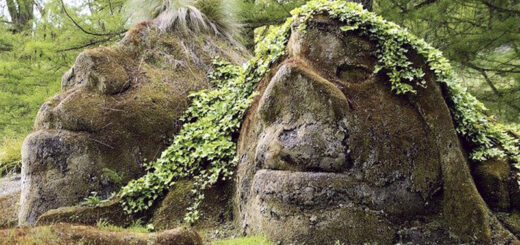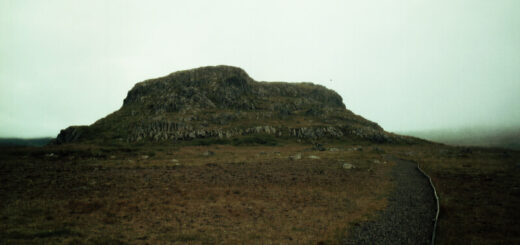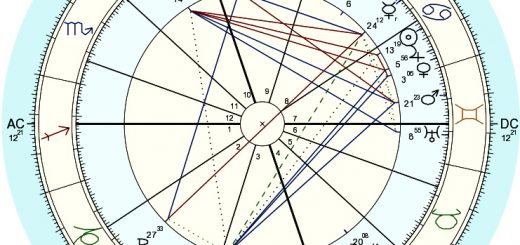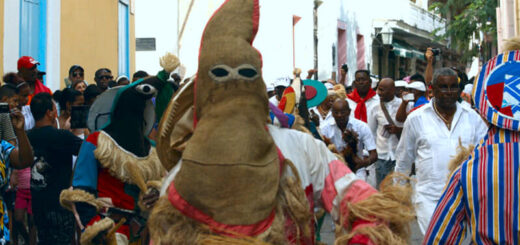Pomba Gira or Pombajira and Exu
A Pomba gira is a spiritual entity within Umbanda, Candomblé, Macumba and Quimbanda, which manifests itself incorporated in a medium. It is the messenger between the world of the orixás and the earth.
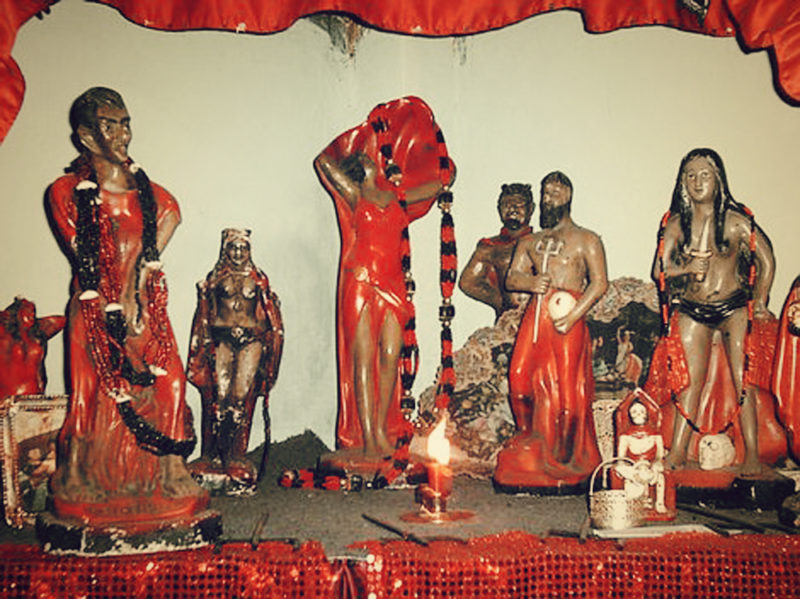
Macumba altar
She named: Pomba Gira, Pombagira, Pombajira, Pombojira, Pambujira, Pombujira, Pombojira, Bombogira, Pombagira or Inzila (in quimbundo: pambu ia-njila , lit. Encruzilhada), in Bantu mythology, she is the linked to the survey of roads, crossroads, bifurcations and communication. In the Afro-Brazilian religious cults mentioned above she is also a protector of especially women.
She is an entity developed out of the spirit of deceased prostitutes, about which there are several semi-historical stories and legends. Worshippers explain her dep understanding of the sorrows of women against this background. Pomba Gira can also be ruthless and demonic when a husband cheats on his wife and shower him with bad luck.
Central entity of a group of spirits
The spirit Pomba Gira is to be understood as a kind of “central entity” of a group of spirits called Pomba Giras, who display the main features of this archetypal Pomba Gira, but with different extra individual qualities, mostly with names that include Pomba Gira, but Maria Molambo or Mulambo is also used and both a Pomba Gira and unique entity. She is the spouse of Exu and where she stands for female sexuality and strength, Exu represents the male machismo, virility, sexuality and power.

Pomba Gira statue, smoking.
Her symbolic colors are red and black. she is often is represented by voluptuous and sensual looking statues, wearing skirts, lace blouses, necklaces, flowers and many ornaments, like a dagger worn under her garter, three red roses, coins and a skull. Offerings she likes are champagne, wine, sweet anis liquor, cigarettes, a mirror, costume jewellery, lipsticks, etc..
The Zelador and Pomba Gira worship
The entity is worshipped by a Zelador, in most cases a woman, who gets possessed in trance by Pomba Gira during gatherings or celebration days, cares for her with offerings, let her speak through her mouth in a specific cackling way and performs rituals in which the entity solves problems (trabalhos espirituais) for her clients.
The Zelador has a complex relationship with her spirits, just like male Macumba and Quimbanda practitioners have complex relations with their Exu’s. These spirits are very powerful, can do the heavy work very accurate and effectively, but if a worshipper/Zelador makes a mistake or forgets the proper offerings these spirits turn violently against their human companions and can bring a lot of bad luck.
Pomba Gira is worshipped in house-temples within the favelas of Rio de Janeiro and other Brazilian cities. She is associated with associated with the number seven, crossroads, graveyards, spirit possession. Also with the protection of women and magical rituals in the service of people who lack a basic need like money, a loyal husband, fertility, safety or love, or for stopping those who do harm te the client.
Female sexuality, beauty and desire
While Exu represents male sexuality, fertility and strength, Pomba Gira personifies female sexuality, beauty and desire. She is depicted as a beautiful woman who is insatiable, fond of cigarettes and sweet liquors. Pomba Gira is venerated with great respect and care because of her reputation for possessing great wrath.
She is often invoked by those who seek aid in matters of the heart and love. Her statues come in great variety, though seldom she is depicted as white. Mostly Latino, Black or red in color, scarcely dressed, naked or half naked and wearing symbols like three red roses and a dagger. The last one wrapped in behind her garter.
Pomba Gira is noted for her connection with both transgender women and effeminate male worshippers and is reputed to possess both. Some representations of Pomba Gira display the characteristics of being promiscuous, talkative in a typical cackling voice and vulgar. However she has many avatars, and will be more or less inclined towards that behavior depending on how she manifests herself.
Pomba Gira forms which can manifest themselves

Red roses are sacred to Pomba Gira.
Dama da Noite (Lady of the Night)
Maria Molambo
Maria Mulambo das Sete Catacumbas (literally, Lame Mary of the Seven Tombs)
Maria Padilha (Queen of the Marys)
Maria Quitéria
Pomba Gira Arrepiada (Creeping Pomba Gira)
Pomba Gira Cigana (Gypsy Pomba Gira)
Pomba Gira das Almas (Pomba Gira of the Souls)
Pomba Gira das Sete Encruzilhadas (Pomba Gira of the Seven Crossroads)
Pomba Gira dos 7 Cruzeiros da Calunga (Pomba Gira of the Seven Crosses of Kalunga)
Pomba Gira Mirongueira (Enchantress Pomba Gira)
Pomba Gira Mocinha (Young Girl Pomba Gira)
Pomba Gira Rainha (Queen Pomba Gira)
Pomba Gira Sete Calungas (Pomba Gira Seven Kalungas)
Praia (Beach)
Rainha das Rainhas (Queen of Queens)
Rainha do Cemitério (Queen of the Graveyard)
Rainha Sete Encruzilhadas (Queen Seven Crossroads)
Rosa Caveira (literally Rose Skull)
Pomba Gira das Cobras (Pomba Gira of Snakes)
Pomba Gira Maria da Praia (Pomba Gira of the Beach)
Pomba Gira, like the ancient goddess Hecate, is often associated with crossroads, probably because the crossroad belongs to the traditional liminal zones, i.e. zones where the material dimension borders the astral realm or underworld. See also our article Hecate, the calling of the crossroad goddess. Statues in a wide variety of Pomba Gira are easily purchased on the Internet. There is also a shop with Pomba Gira astral powder to make a connection.
Exu
Exu is the name of a god and (as the husband of Pomba Gira) a spirit in an evolutionary state. The Latter Exu is also named Exu de Umbanda. These two Exus shoul not be confused with each other as they are different entities.
Exu is the orixá of communication, patience, order and discipline. He also represents vitality and male sexuality and is the guardian of the villages, cities, houses. He also is the active force behind, of the things that have to be done in general and of human behavior. The word Èșù, in Yoruba, means ‘sphere’, and, in fact, Exu is the orixá of the movement. He is the one who should receive the offerings in the first place in order to ensure that all goes well and to ensure that his role as messenger between the Orun (the spiritual world) and the Aiye (the material world) is fully realized.
Not the Devil
In Africa in the 16th century, at the time of European colonization, Exu was mistakenly syncretized with the Christian devil by the colonizers, due to his irreverent, playful style and the way he is represented in African worship. For being provocative, indecent, astute and sensual, he is commonly confused with the figure of Satan, which is a mistake, according to Yoruba theology, since he is not in opposition to God and not considered an embodiment of evil.
In this religion, there are no devils or entities in charge solely and exclusively of bad things, as in Christianity, according to which everything bad that happens is the fault of a single being who was expelled by God. In Yoruba mythology, however, as in Candomblé, each one of the Divinities (Orixás) has its positive and negative portions, as well as any human being of flesh and blood.

African statue of a phallic Legba or Elegba who is often identified as Exu or Eshu. There is the African saying: As Òdàrà, he receives, as Ẹlégbára, makes it happen, and as Òjíṣé leads the return. All this is Èṣù (Exu) – Olódùmarè
With an irascible character, Exu is pleased to provoke disputes and bring calamities to the people who he dislikes. However Exu works positively when treated well. That is why Exu is considered the most human of the Orixás, because his character resembles that of us humans. Exu is also associated with (E)legba.
The Yoruba worship Exu in a piece of porous stone called Yangi, or make a mound grotesquely shaped in human form with eyes, nose and mouth made of whelk. Or they represent Exu in a statue adorned with rows of whelks, and having in his hands little gourds where he, Exu, carries several powders of elements of the earth, used in a very precise way in his work.
Exu has the ability to be the most subtle and astute of all the Orixás. And when people are at fault with him, he simply provokes misunderstandings and discussions between them and sets them numerous traps.
Exu in Brazil
In Brazil, in candomblé, Exu is one of the most important Orixás and is always the first to receive offerings, songs and prayers: he is greeted before all Orixás , before any ceremony or event. The Exu-Orixá does not incorporate in anybody to give consultations as the exus of umbanda do, they are seated in the entrance of the houses of candomblé as guardians, and in every house of candomblé there is a room for Exu, always separate from the other orixás, where are all the settlements of the exus of the house and the children of saint that have Exu seated.
He is astute, vain, cultured and owner of great wisdom, great connoisseur of human nature and worldly affairs, hence the assimilation with the devil by the first missionaries who, frightened, made him the symbol of evil and hatred. But “… not completely bad, nor completely good …”, in Pierre Verger’s view in the text of his authorship “Initiation” – contained in the documentary “Iconography of African Gods in the Candomblé of Bahia”, Exu reacts favourably when treated conveniently.
Exu receives several names, according to his function or qualities: Elegbá or Elegbá, Bará or Ibará, Alaketu, Agbô, Odara, Akessan, Lalu, Ijelu (who governs the birth and growth of all that exists), Ibarabo, Yangi, Baraketu (guardian of the gates), Lonan (guardian of the ways), Iná (revered in the ceremony of the padê).
Monday is the day of the week consecrated to Exu. Its colors are red and black; its symbol is the ogre (stick with gourds that represents the phallus); its beads and colors are black and red; the offerings are goats and cocks, black preferably, and brandy, accompanied by foods made in palm oil. One Exu-offering consists of a plate of yellow farofa, acaçá, oil-de-dendê and a quartinha of water or cachaça, which are “lowered” to Exu. His greeting is “Larôye!” which means the good speaker and communicator.
In the nation of Angola, Exu is called Aluvaiá. In Candomblé jeje he is called Pombajira and Legbá. As explained before he should not be confused with the entity Exu de Umbanda. The Exus de Umbanda are entities of disembodied people who, for reasons of spiritual evolution, returned to earth to fulfil this mission with their followers. These entities are confused with Esu or Exu of the Candomblé due to the proximity that Exu has with men. However, they are not considered Orixás like Exu, but spiritual entities in evolution. They should not be confused with quiumbas – knowing the wills of men and women on the earth plane, where they lived at different times, with the same problems, desires and dreams.
Exu In Cuba
In Cuba, he is called Elegbara, Elegua, Elegguá or Eleggua. It is one of the deities of the Yoruba religion. In the santería, Exu is syncretized with the Santo Niño of Atocha or with the Santo Antonio of Padua. He is the doorman of all roads, mountain and savannah, the first of the four warriors next to Oggun, Osun and Oshosi.
He has 201 paths, its colors are red and black and its numbers are 3 and 7. He is the communicator and Ifá gave him four búzios to talk to him. He is present in the beginning of life and in the hour of death.
In Haiti
In Haitian voodoo, it is called Papa Legba and Legbá Petró, Maitre Carrefour (“owner of the crossroads”). He is the intermediary between the loa and humanity. He dwells at a spiritual crossroads and gives (or denies) permission to speak with the spirits of Guinee. Papa Legba is also believed to speak all human languages. He is always the first and last spirit invoked in any ceremony. In the Dominican Republic, he is worshipped as Vodun Legba, and in Trinidad and Tobago as Eshu.
See also:
Grimoires, instruction books on magic
Voodoo amulets and their Loas
Voodoo
Marie Laveau and the Magic of New Orleans Voodoo Queens
Umbanda, Brazilian Vodum and Santeria
Palo and Hoodoo
Charms to avoid injuries and gain psychic power
Potent Clove and the power of Bluestone


